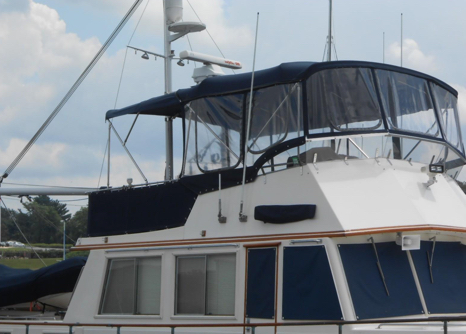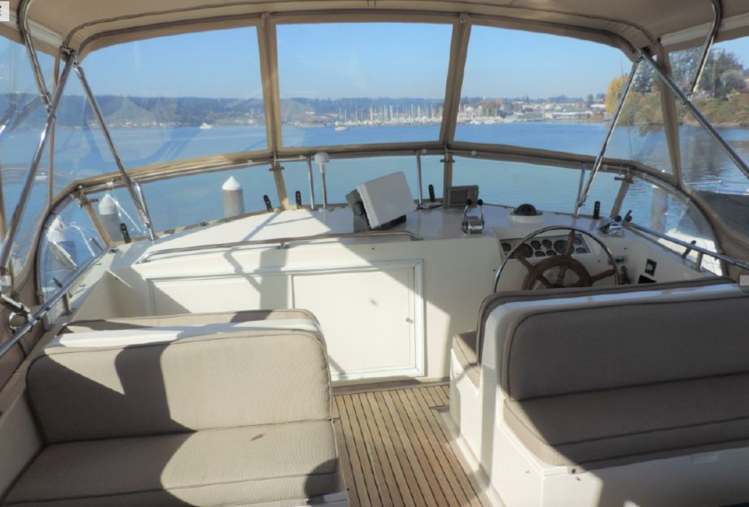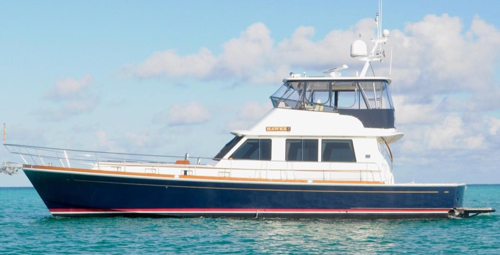We see so many Grand Banks yachts for sale and in our Dickerson Harbor boatyard for repairs that have not had their boat canvas and eisenglass enclosures taken care of properly. We are going to give you some advice on the whole range of topics around flybridge enclosures and how to maintain them, so they give you many years of service.
Right upfront, it’s important to say that a flybridge enclosure with a full bimini top is one of the best investments you will make. The flybridge teak deck on the older Grand Banks boats will look “just like new” if the boat has had a full bimini and the deck hasn’t been treated harshly with scrubbing or oiling. Beyond those valuable teak decks, the full enclosure will also protect all the equipment on the flybridge; cushions, electronics, varnished teak, chairs, and everything including the people from the cold and rain. It also keeps your flybridge clean so you can enjoy it without scrubbing every other day.

Now, some people just like the open-air feel of a flybridge without the enclosure, just a bimini. With a Grand Banks, this makes some sense if the owner prefers to just go below and steer from the Salon. If the only consideration was to get out of the rain and cold, the full enclosure is not a mandatory option. When you consider all the other benefits, the full enclosure on any Grand Banks yacht becomes a great investment over the long term.
If you are going to have a NEW flybridge enclosure made for you Grand Banks, here are some tips to help with what you choose. Overall, we would say that QUALITY materials and craftsmanship are vital if you are going to make the investment. Please don’t go to a canvas shop run out of the back of a pickup truck for your enclosure. You will be unhappy when the sad day comes that the seams are coming loose, the zippers won’t work, or the glass has become yellow and cracked. Your supplier will be long gone. Going to a reputable sail and canvas shop will make it a lot more likely you are going to get a high-quality solution.

The key question you should ask yourself is whether you want a 10 to 15-year enclosure that you are going to take care of and will make your money back on resale. Or, do you want a 5-year enclosure that you will let the next owner worry about and just deduct it from your resale? The 15-year flybridge enclosures have these attributes:
- Canvas will be Sunbrella Marine Grade fabric. There are lots of other similar brands out there and if you don’t specify it, you will often get a lower cost material
- Thread will be a “Lifetime Thread” like Profilen® or Tenara®. These threads will come with a lifetime guarantee and will withstand the elements and cleaning abuse
- The clear plastic glass will be Strataglass. This is the brand name of what is commonly called eisenglass, isinglas, or clear vinyl. As with everything, there are other brands, but Strataglass is the choice for your fine Grand Banks. It comes in three gauges; 30, 40 and 60. There is a “light smoke” option in the 40 gauge. For information on the often-used name eisenglass: o Eisenglass is an old product that hasn’t been made for years, though it is the common name for clear plastic windows on boats o Isinglass is made from the fish bladder and is used to clarify wine, nothing to do with boat enclosures. Often Eisenglass is spelled this way o Strataglass is what you want!
- Production by a high-quality sail and canvas shop. The Strataglass website has over 700 authorized fabricators in the USA, so that’s a great place to start.
For the ongoing maintenance of your new full enclosure, here are some tips to keep it looking great for a very long time:
- The number one thing to protect your clear plastic is to keep suntan lotion off it. Spray suntan lotion should always be banned from the flybridge. Make sure your hands are clean if you are touching the windows. Even bananas can cause it to yellow quickly
- The number two thing that can preserve your clear windows is to store the boat out of the sun when it’s not in use. Covered storage to keep the sun off a boat is one of the best investments you can ever make
- Rinse the windows EVERY time you use the boat. You can air dry them or use a microfiber cloth
- Clean the windows every couple of weeks, when in use, with “Strataglass Protective Cleaner” from IMAR. Spot clean with the same cleaner anytime you touch the windows with anything potentially harmful
- Every couple of months, polish the windows with Strataglass Protective Polish, also from IMAR. For Strataglass windows, this is required to maintain the warranty, that’s how important it is
- At OYA, we have had excellent results using similar products from Meguiar’s®. They make a full line of boat products that are excellent
- Store your windows in ONLY one of two ways. First is to leave them attached but fully zipped up and tight. Don’t leave them rolled up. The second, and best option if left for an extended time, is to lay them out flat on a bunk with a clean sheet in between each window. The plastic can pick up images from anything that has patterns or colors in them, so use nice white sheets between each window for storing your inside

For the canvas, Sunbrella, part of your enclosure and bimini here are a few tips
- Rinse the bimini canvas and stainless tubes each time you use the boat
- About every 6 months, take the bimini top and enclosure off the boat and clean the canvas parts with a mild soap in a “rug doctor” type cleaner. You will be amazed at how dirty the canvas can get in a few months. Clean the windows flat on a fabric-covered table.
- While you have the canvas off, fully polish and wax the stainless tubes. This is essential to help keep the harmful metal polishes off the canvas
- About once a year, after you clean your enclosure canvas on-shore with the rug doctor, seal the bimini Sunbrella fabric with “303 Fabric Guard” protectant. This is usually a three-step process. The first is a full sealing off the boat. Then there is a check-in a good rainstorm and touching up any leaks when it dries. There is often a final step of getting that one last leak. This sounds tedious, but it’s required if you want a leak-tight full enclosure
For those enclosure windows that have seen better days, here is how we handle them at our Dickerson Harbor boatyard. We see this all too often, particularly on boats that are ready to be sold. The boat comes in with 3 of the 8 enclosure windows totally shot. They are yellow, cracked and generally a turnoff to a new buyer.
These windows are expensive, typically $350 per panel, so we save as many as we can. Here’s how we handle this situation; it’s tedious work requiring a lot of care to get right.
- First, we remove the three windows that have to be replaced. We send these to the finest sail and canvas shop in Annapolis to be replaced with Strataglass clear windows. We specify a lifetime thread. Usually, we can save the existing canvas material. The zippers are inspected and replaced if necessary. Before taking them to your sailmaker, we completely clean the fabric around the windows with our “rug doctor” cleaning machine
- For the other 5 windows, we are going to save them by compounding, polishing, and waxing
- It all starts with a good cleaning with water and a mild soap followed by a thorough rinsing
- Once they are dry, we set up a couple of tables covered with clean fabric, so no more scratches are created
- Step 2 is compounding the windows with a product like Meguiare’s Heavy Duty Vinyl Cleaner or “Star Brite Plastic Scratch Remover”. This may take several steps of compounding, cleaning, and inspecting on the boat to see if you are making progress.
- Once you have the windows looking salvageable, the next step is to remove as many of the scratches as possible. For this, we use Meguiare’s Clear Plastic Cleaner. Again, a couple of steps of this, with a good inspection on the boat, will be necessary to get excellent results
- The final step is to protect all your hard work. An excellent product for this is Meguiar’s Mirror Glaze Clear Plastic Polish which will leave a nice protective film on the windows.
For a great discussion of clear vinyl window products, check out this 2009 article from Practical Sailor.
A good quality full enclosure for a Grand Banks yacht typically costs $10K to $15K, depending on the size boat. It’s a great addition to the value of your boat, but only if you have it done professionally and use the best materials. Once you have a nice enclosure, it really pays to take care of your investment with regular cleaning, polishing and sealing with the right products.
For more information contact us at www.OYA.com or call at 410-822-8556.

